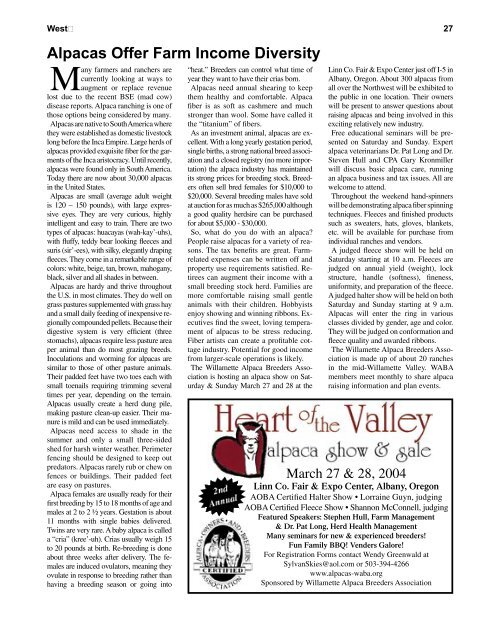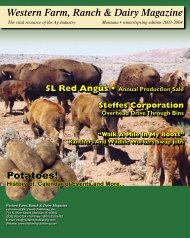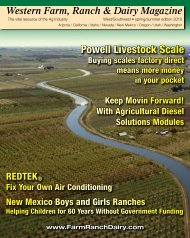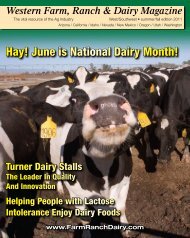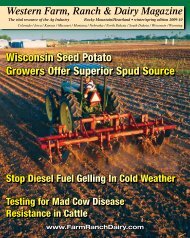Western Farm, Ranch & Dairy Magazine - Ritz Family Publishing, Inc.
Western Farm, Ranch & Dairy Magazine - Ritz Family Publishing, Inc.
Western Farm, Ranch & Dairy Magazine - Ritz Family Publishing, Inc.
You also want an ePaper? Increase the reach of your titles
YUMPU automatically turns print PDFs into web optimized ePapers that Google loves.
West 27<br />
Alpacas Offer <strong>Farm</strong> <strong>Inc</strong>ome Diversity<br />
Many farmers and ranchers are<br />
currently looking at ways to<br />
augment or replace revenue<br />
lost due to the recent BSE (mad cow)<br />
disease reports. Alpaca ranching is one of<br />
those options being considered by many.<br />
Alpacas are native to South America where<br />
they were established as domestic livestock<br />
long before the <strong>Inc</strong>a Empire. Large herds of<br />
alpacas provided exquisite fiber for the garments<br />
of the <strong>Inc</strong>a aristocracy. Until recently,<br />
alpacas were found only in South America.<br />
Today there are now about 30,000 alpacas<br />
in the United States.<br />
Alpacas are small (average adult weight<br />
is 120 – 150 pounds), with large expressive<br />
eyes. They are very curious, highly<br />
intelligent and easy to train. There are two<br />
types of alpacas: huacayas (wah-kay’-uhs),<br />
with fluffy, teddy bear looking fleeces and<br />
suris (sir’-ees), with silky, elegantly draping<br />
fleeces. They come in a remarkable range of<br />
colors: white, beige, tan, brown, mahogany,<br />
black, silver and all shades in between.<br />
Alpacas are hardy and thrive throughout<br />
the U.S. in most climates. They do well on<br />
grass pastures supplemented with grass hay<br />
and a small daily feeding of inexpensive regionally<br />
compounded pellets. Because their<br />
digestive system is very efficient (three<br />
stomachs), alpacas require less pasture area<br />
per animal than do most grazing breeds.<br />
Inoculations and worming for alpacas are<br />
similar to those of other pasture animals.<br />
Their padded feet have two toes each with<br />
small toenails requiring trimming several<br />
times per year, depending on the terrain.<br />
Alpacas usually create a herd dung pile,<br />
making pasture clean-up easier. Their manure<br />
is mild and can be used immediately.<br />
Alpacas need access to shade in the<br />
summer and only a small three-sided<br />
shed for harsh winter weather. Perimeter<br />
fencing should be designed to keep out<br />
predators. Alpacas rarely rub or chew on<br />
fences or buildings. Their padded feet<br />
are easy on pastures.<br />
Alpaca females are usually ready for their<br />
first breeding by 15 to 18 months of age and<br />
males at 2 to 2 ½ years. Gestation is about<br />
11 months with single babies delivered.<br />
Twins are very rare. A baby alpaca is called<br />
a “cria” (kree’-uh). Crias usually weigh 15<br />
to 20 pounds at birth. Re-breeding is done<br />
about three weeks after delivery. The females<br />
are induced ovulators, meaning they<br />
ovulate in response to breeding rather than<br />
having a breeding season or going into<br />
“heat.” Breeders can control what time of<br />
year they want to have their crias born.<br />
Alpacas need annual shearing to keep<br />
them healthy and comfortable. Alpaca<br />
fiber is as soft as cashmere and much<br />
stronger than wool. Some have called it<br />
the “titanium” of fibers.<br />
As an investment animal, alpacas are excellent.<br />
With a long yearly gestation period,<br />
single births, a strong national breed association<br />
and a closed registry (no more importation)<br />
the alpaca industry has maintained<br />
its strong prices for breeding stock. Breeders<br />
often sell bred females for $10,000 to<br />
$20,000. Several breeding males have sold<br />
at auction for as much as $265,000 although<br />
a good quality herdsire can be purchased<br />
for about $5,000 - $30,000.<br />
So, what do you do with an alpaca?<br />
People raise alpacas for a variety of reasons.<br />
The tax benefits are great. <strong>Farm</strong>related<br />
expenses can be written off and<br />
property use requirements satisfied. Retirees<br />
can augment their income with a<br />
small breeding stock herd. Families are<br />
more comfortable raising small gentle<br />
animals with their children. Hobbyists<br />
enjoy showing and winning ribbons. Executives<br />
find the sweet, loving temperament<br />
of alpacas to be stress reducing.<br />
Fiber artists can create a profitable cottage<br />
industry. Potential for good income<br />
from larger-scale operations is likely.<br />
The Willamette Alpaca Breeders Association<br />
is hosting an alpaca show on Saturday<br />
& Sunday March 27 and 28 at the<br />
Linn Co. Fair & Expo Center just off I-5 in<br />
Albany, Oregon. About 300 alpacas from<br />
all over the Northwest will be exhibited to<br />
the public in one location. Their owners<br />
will be present to answer questions about<br />
raising alpacas and being involved in this<br />
exciting relatively new industry.<br />
Free educational seminars will be presented<br />
on Saturday and Sunday. Expert<br />
alpaca veterinarians Dr. Pat Long and Dr.<br />
Steven Hull and CPA Gary Kronmiller<br />
will discuss basic alpaca care, running<br />
an alpaca business and tax issues. All are<br />
welcome to attend.<br />
Throughout the weekend hand-spinners<br />
will be demonstrating alpaca fiber spinning<br />
techniques. Fleeces and finished products<br />
such as sweaters, hats, gloves, blankets,<br />
etc. will be available for purchase from<br />
individual ranches and vendors.<br />
A judged fleece show will be held on<br />
Saturday starting at 10 a.m. Fleeces are<br />
judged on annual yield (weight), lock<br />
structure, handle (softness), fineness,<br />
uniformity, and preparation of the fleece.<br />
A judged halter show will be held on both<br />
Saturday and Sunday starting at 9 a.m.<br />
Alpacas will enter the ring in various<br />
classes divided by gender, age and color.<br />
They will be judged on conformation and<br />
fleece quality and awarded ribbons.<br />
The Willamette Alpaca Breeders Association<br />
is made up of about 20 ranches<br />
in the mid-Willamette Valley. WABA<br />
members meet monthly to share alpaca<br />
raising information and plan events.<br />
March 27 & 28, 2004<br />
Linn Co. Fair & Expo Center, Albany, Oregon<br />
AOBA Certified Halter Show • Lorraine Guyn, judging<br />
AOBA Certified Fleece Show • Shannon McConnell, judging<br />
Featured Speakers: Stephen Hull, <strong>Farm</strong> Management<br />
& Dr. Pat Long, Herd Health Management<br />
Many seminars for new & experienced breeders!<br />
Fun <strong>Family</strong> BBQ! Venders Galore!<br />
For Registration Forms contact Wendy Greenwald at<br />
SylvanSkies@aol.com or 503-394-4266<br />
www.alpacas-waba.org<br />
Sponsored by Willamette Alpaca Breeders Association


